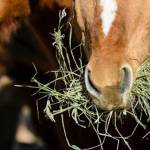Study Links Feed Management and Reproductive Success in Horses

Horses are designed to eat small amounts at a time, with forage always available for nibbling. Modern management practices are often quite different, with limited access to forage, one or more large grain meals each day, and long periods when the horse has nothing to eat. However, research on feed management has consistently turned up the same conclusion: horses tend to stay healthiest and most content when their feeding plan closely follows the natural pattern. A recent study of broodmare fertility showed the same result.
The study was conducted at the Tunisian national breeding facility in Sidi Thabet. One hundred mares was divided into two groups. The mares were mature, ranging in age from 4 to 21 years old. Mares in one group (limited feeding) were given one feeding of 10 kg (22 lb) of hay in the stalls where they spent the night. Mares in the other group (continuous feeding) received half the amount of hay during the day and the remainder at night in their stalls. All mares were stalled 17 hours and turned out 7 hours each day. They also received barley as a daily concentrate.
All mares were checked for breeding readiness by teasing and also by rectal palpation and ultrasound. Each mare was then bred by live cover or artificially inseminated with fresh or frozen semen. Mares in the continuous feeding group had a conception rate of 81% with only two estrus abnormalities. Mares in the limited feeding group had a conception rate of 55% and showed 16 estrus abnormalities.
With identical patterns of turnout and the same daily total consumption of hay and grain, the difference in hay feeding was the only identified variable. The researchers suggested that having hay available on a semi-continuous basis might have reduced stress and kept the mares’ digestive systems operating more normally than when hay was fed only once a day. Their recommendation was to keep mares as close as possible to a natural pattern of foraging behavior in order to maximize reproductive potential.








